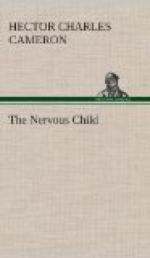Fortunately in all save the rarest possible instances the apnoea yields and a deep inspiratory movement follows. As the air rushes past the glottis, which is still partially closed, a sound recalling the whoop of pertussis is heard. Often this recurs throughout all the burst of crying which follows, and each inspiration is accompanied by a shrill stridulous sound. With the re-establishment of respiration the cyanosis rapidly fades, to be succeeded in some cases by pallor and perspiration.
It need hardly be said that we should do all in our power to prevent these alarming and distressing attacks. Each seizure predisposes to a repetition. In some children we notice that months and even years after an attack of whooping-cough, a slight bronchial catarrh may be sufficient to bring back the characteristic cough. In laryngismus in the same way we may suppose that the reflex path is made easy and the resistance lowered by constant use. Fortunately the spasms are not usually difficult to control. Calcium bromide, in doses of from two to four grains, according to age, three times daily, is generally successful with or without the addition of chloral hydrate in small doses. At the same time we must endeavour in every way possible to keep the child calm, by paying close attention to nursery management. The child with spasmophilia is as a rule excitable and easily upset, and although calcium bromide is a drug which offers powerful aid it is not able to achieve its effect unless we are able at the same time to guarantee a reasonable immunity from emotional upsets. It is for this reason that I have included some description of laryngismus, although its origin is undoubtedly very different from that of the other disorders of conduct which we have examined.




